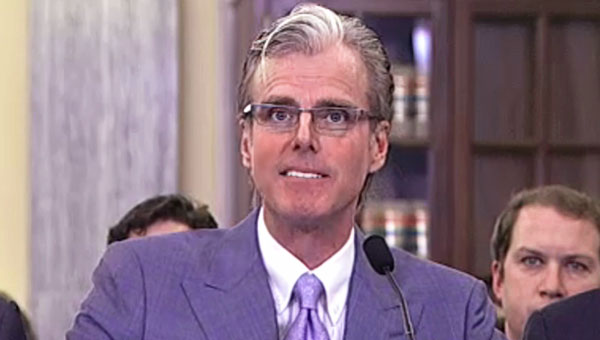For one brief shining moment, it appeared that Amazon and the Federal Aviation Administration were in concert on outdoor drone testing in the U.S., but in testimony before a Senate subcommittee hearing held Tuesday, Amazon put paid to that notion.
Although the FAA last week granted Amazon permission to conduct outdoor tests, the unmanned aircraft system covered by the authorization is no longer in use.
“The good news is that, while the FAA was considering our applications for testing, we innovated so rapidly that the UAS approved last week by the FAA has become obsolete. We don’t test it anymore. We’ve moved on to more advanced designs that we already are testing abroad,” Paul Misener, VP for global public policy at Amazon, told members of the Subcommittee on Aviation Operations, Safety, and Security.
The bad news is that Amazon does not yet have the FAA’s permission to test its latest UAS outdoors in the U.S., although other countries have moved swiftly to approve it.
For the past year, Amazon has been agitating to get the FAA to pick up the pace of its approval process.
“We need permission to rapidly modify our test vehicles, without administrative delays associated with every change,” Misener said.
“Obtaining permission took far too long, and certainly much longer — over half a year– than it took in other countries,” he noted.
Other countries, including the UK, also take a less restrictive approach to regulation, Misener told the senators.
In fact, the FAA gives greater leeway to noncommercial, amateur UAS fliers in the U.S. than it gives to Amazon’s team of experts, which includes a former NASA astronaut, he pointed out.
Positive Steps
If the FAA moves swiftly to authorize testing of Amazon’s current UAS technology, it could mean that the Mexican standoff over drone deliveries has indeed come to an end.
If authorization similar to the certificate awarded last week were granted, it could move Amazon’s research forward in the U.S. and reduce the probability “that much of the related technology would be developed outside of the U.S.,” said Rob Enderle, principal analyst at the Enderle Group, told the E-Commerce Times.
That certificate requires Amazon to conduct all flight operations at a maximum height of 400 feet, during daylight hours and in visual meteorological conditions, meaning clear of clouds and weather. The UAS must remain within the pilot’s and observer’s visual line of sight at all times.
The pilot flying the aircraft must have at least a private pilot’s certificate and current medical certification.
Those requirements are probably imposed because, while the aircraft must remain in line of sight, “they will be testing beyond line of sight (BLOS) and see-and-avoid systems, and would consider this operation safer with a trained pilot at the controls should malfunctions occur,” remarked Michael Blades, a senior industry analyst at Frost & Sullivan.
“Think of [the pilot] as a drone test pilot,” he told the E-Commerce Times.
“Eventually, all this will be automated and instrumented, preventing [accidents] — but during testing, that generally won’t be the case,” Enderle remarked.
Under last week’s certification, Amazon has to report monthly to the FAA on the number of flights conducted, pilot duty time per flight, unusual hardware or software malfunctions, any deviations from air traffic controllers’ instructions, and any unintended loss of communications links.
Those reporting requirements are standard for all UAS experimental airworthiness certificates, the FAA said, and presumably would apply to future authorizations.
The FAA “is learning from practices that are already in place in Europe, Australia and Canada, and plans to use information collected from test sites and comments from the Notice of Proposed Rulemaking to make safe and effective rules,” Blades said.
FAA’s Cautionary Stance
The certificate’s overall requirements aren’t too strict, Blades maintained, because safety requirements are more stringent for experimental systems.
“Flying drones above 500 feet [puts them] in the same airspace as passenger traffic,” he pointed out.
Further, BLOS “still has several years of development before implementation,” Blades said, and methods for air traffic controllers to track drones, and systems for avoiding collisions, are “being developed but won’t be robust enough for efficient or safe operation for five-10 years.”
That could in part be due to FAA foot-dragging, however.
“Although the FAA has asked a subcommittee of one of its industry advisory committees to examine beyond visual line of sight operations — and I am a member of this subcommittee — the group has only met twice since its inception last year,” Michener said in his testimony on Tuesday. “This low level of government attention and slow pace are inadequate, especially compared to the regulatory efforts in other countries.”
Implications for Amazon’s Plans
It will take “at least five years” for Amazon’s plan to use drones for delivery, Blades suggested, because “it will take at least that long to develop a system that ensures safety and prevents loss or theft.”
That might cost Amazon plenty.
“Amazon isn’t a drone company,” Enderle pointed out. “Google, which owns both robotics and drone companies, could move on this opportunity far faster than Amazon can, and is better connected with the current administration than Amazon is.”
Meanwhile, out in North Dakota, Grand Sky, the first commercial UAS business and aviation park in the U.S., is open for business.
It offers 1.2 million square feet of hangar, office, shop, laboratory and data center space and is backed by private equity investors seeking opportunities in the commercial UAS market. It’s an FAA-designated UAS test site.
In a few years, Enderle said, “we’re likely to be up to our armpits in drones.”























































Social Media
See all Social Media